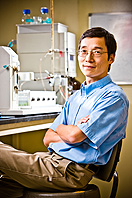News
New techniques for stapling peptides
could spur drug development
-
 Print
Print -
 Comments
Comments
-

Chemist Qing Lin has devised two new ways of “stapling” peptides, which could lead to new treatments for a health problems such as cancer and inflammatory, metabolic and infectious diseases. Photo: DOUGLAS LEVERE
UB researchers have devised two new ways of “stapling” peptide helices to prevent these medically important molecules from losing their shape and degrading in the presence of enzymes.
The discovery could help speed the development of peptide-based drugs against diseases, including cancer. UB scientists say the methods they pioneered are simpler than existing techniques, one of which employs an expensive ruthenium catalyst to connect chemical side chains that protrude from the main body of helical peptides.
“There’s a lot of potential here. Our chemistry is unique,” says Qing Lin, UB assistant professor of chemistry who led the research. “There are not that many new drug targets out there today, which partly explains the declining number of FDA-approved new drugs in recent years. So there’s a need to come up with new technologies that can overcome this barrier. To this end, stapled peptides could open a whole host of new targets for therapies.”
Stapled peptides work as treatments against disease by binding tightly to target proteins within cells, thus disrupting specific protein-protein interactions that regulate many biological processes, including response to stress, signaling within cells and cell death.
In their native state, peptides—short strings of amino acids—shift between different shapes, including a helix, sheet and random coil. Stapling the peptides’ side chains encourages the peptides to adopt and stay in a helix, which enables them to enter cells more easily. The helical conformation also makes it more difficult for enzymes to break the peptides down, Lin says.
The two processes Lin’s team developed for stapling peptides are efficient, producing stapled peptides in high yields, says Timothy Dee, a commercialization manager for UB’s Office of Science, Technology Transfer and Economic Outreach (STOR). Through STOR, UB is applying for patents to cover both stapling methods.
“Photoclick stapling,” the first approach, involves synthesizing peptides that have alkenes in one side chain and tetrazoles in another. Under ultraviolet light, the two side chains form chemical bonds with one another.
A paper on photoclick stapling appeared online in Bioorganic and Medicinal Chemistry Letters in January and will appear later this year in the journal’s print edition. Researchers first published on the subject in 2009 in Chemical Communications.
The second stapling technique Lin and his colleagues devised requires the synthesis of peptides carrying a pair of amino acids called cysteines that contain sulfur in their side chains. When scientists expose these peptides to a chemical that reacts selectively with the sulfur atoms, the chemical forms a “staple” that connects the two cysteine side chains.
Experts believe stapled peptides could treat a wide variety of health problems, including cancer and inflammatory, metabolic and infectious diseases. As evidence of the technology’s promise, a company formed in 2005 to commercialize a ruthenium-based stapling method developed at Harvard University has reportedly raised about $60 million in venture capital and landed a deal with pharmaceutical giant Roche that could be worth more than $1 billion over time.
“The field is large enough for multiple players,” Lin says. “Stapling is a technology that many people believe will create a new class of drug therapies, hitting new targets that other therapies can’t. Our chemistry is distinct from what’s already out there.”
Lin and his group are particularly interested in developing anti-cancer therapeutics that increase the efficacy of chemotherapy by instructing cancer cells to self-destruct through “programmed cell death,” a process called apoptosis.

Reader Comments